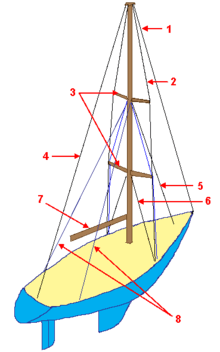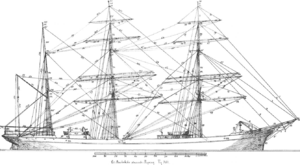Rigging


Key: 1. Forestay 2. Shroud 3. (Spreaders) 4. Backstay 5. Inner forestay 6. Sidestay 7. (Boom) 8. Running backstays


1. Main sheet 2. Jib sheet 3. Boom vang 4. Downhaul 5. Jib halyard
Rigging comprises the system of ropes, cables and chains, which support a sailing ship or sail boat's masts—standing rigging, including shrouds and stays—and which adjust the position of the vessel's sails and spars to which they are attached—the running rigging, including halyards, braces, sheets and vangs.[1]
Etymology
According to the Encyclopædia Britannica Eleventh Edition "rigging" derives from Anglo-Saxon wrigan or wringing, "to clothe". The same source points out that "rigging" a sailing vessel refers to putting all the components in place to allow it to function, including the masts, spars, sails and the rigging.[2]
Types of rigging
Rigging is divided into two classes, standing, which supports the mast (and bowsprit), and running, which controls the orientation of the sails and their degree of reefing. Configurations differ for each type of rigging, between fore-and-aft rigged vessels and square-rigged vessels.
Standing
Standing rigging is cordage which is fixed in position. Standing rigging is almost always between a mast and the deck, using tension to hold the mast firmly in place. Due to its role, standing rigging is now most commonly made of steel cable. It was historically made of the same materials as running rigging, only coated in tar for added strength and protection from the elements.[3]
Fore-and-aft rigged vessels
Most fore-and-aft rigged vessels have the following types of standing rigging: a forestay, a backstay, and upper and lower shrouds (side stays). Less common rigging configurations are diamond stays and jumpers. Both of these are used to keep a thin mast in column especially under the load of a large down wind sail or in strong wind. Rigging parts include swageless terminals, swage terminals, shackle toggle terminals and fail-safe wire rigging insulators.[4]
Square-rigged vessels
Whereas 20th-century square-rigged vessels were constructed of steel with steel standing rigging, prior vessels used wood masts with hemp-fiber standing rigging. As rigs became taller by the end of the 19th century, masts relied more heavily on successive spars, stepped one atop the other to form the whole, from bottom to top: the lower mast, top mast, and topgallant mast. This construction relied heavily on support by a complex array of stays and shrouds. Each stay in either the fore-and-aft or athwartships direction had a corresponding one in the opposite direction providing counter-tension. Fore-and-aft the system of tensioning started with the stays that were anchored at in front each mast. Shrouds were tensioned by pairs deadeyes, circular blocks that had the large-diameter line run around them, whilst multiple holes allowed smaller line—lanyard—to pass multiple times between the two and thereby allow tensioning of the shroud. In addition to overlapping the mast below, the top mast and topgallant mast were supported laterally by shrouds that passed around either a platform, called a "top", or cross-wise beams, called "crosstrees". Each additional mast segment is supported fore and aft by a series of stays that led forward. These lines were countered in tension by backstays, which were secured along the sides of the vessel behind the shrouds.[5]
Running
Running rigging is the cordage used to control the shape and position of the sails. Materials have evolved from the use of Manilla rope to synthetic fibers, which include dacron, nylon and kevlar.[6] Running rigging varies between fore-and-aft rigged vessels and square-rigged vessels. They have common functions between them for supporting, shaping and orienting sails, which employ different mechanisms. For supporting sails, halyards (sometimes haulyards), are used to raise sails and control luff tension. On gaff-rigged vessels, topping lifts hold the yards across the top of the sail aloft. Sail shape is usually controlled by lines that pull at the corners of the sail, including the outhaul at the clew and the downhaul at the tack on fore-and-aft rigs. The orientation of sails to the wind is controlled primarily by sheets,[6] but also by braces, which position the yard arms with respect to the wind on square-rigged vessels.[5]
See also
References
- ↑
Editors (2017). "Definition of rigging in English: rigging". en.oxforddictionaries.com. Oxford University Press. Retrieved 2017-01-02.
The system of ropes or chains employed to support a ship's masts (standing rigging) and to control or set the yards and sails (running rigging).
- ↑ Chisholm, Hugh (1911). "Rigging". The Encyclopedia Britannica: A Dictionary of Arts, Sciences, Literature and General Information. 23 (11 ed.). Encyclopedia Britannica Company. pp. 338–341. Retrieved 2017-01-02.
- ↑ Ward, Aaron (1884). Text-book of Seamanship: The Equipping and Handling of Vessels Under Sail Or Steam. For the Use of the United States Naval Academy. D. Van Nostrand. p. 673.
- ↑ Westerhuis, Rene (2013). Skipper's Mast and Rigging Guide. Adlard Coles Nautical. London: Bloomsbury. p. 5. ISBN 9781472901491.
- 1 2 zu Mondfeld, Wolfram (2005). Historic Ship Models. Sterling Publishing Company, Inc. p. 352. ISBN 9781402721861.
- 1 2 Howard, Jim; Doane, Charles J. (2000). Handbook of Offshore Cruising: The Dream and Reality of Modern Ocean Cruising. Sheridan House, Inc. p. 468. ISBN 9781574090932.
Further reading
- Harland, John (1984). Seamanship in the Age of Sail. Illus. by Mark Myers. Annapolis, Md: Naval Institute Press. ISBN 0-87021-955-3. OCLC 11036800.
- Lees, James (1984). The Masting and Rigging of English Ships of War, 1625–1860 (revised ed.). Annapolis, Md: Naval Institute Press. ISBN 0-87021-948-0. OCLC 11908132.
- Marchaj, C. A. (2000). Aero-Hydrodynamics of Sailing (3rd ed.). Saint Michaels, Md.: Tiller Publishing. ISBN 1-888671-18-1. OCLC 62546510.
- Marchaj, C. A. (2003). Sail Performance: Theory and Practice (Revised ed.). Maidenhead, Berkshire, England: McGraw Hill. ISBN 0-07-141310-3. OCLC 51913243.
- Underhill, Harold A. (1964). Masting and Rigging: The Clipper Ship and Ocean Carrier. Brill Academic Pub. ISBN 9780851741734.
External links
| Wikimedia Commons has media related to Rigging. |
- Photos of different types of ship rigging
- Sail Ship Rigging, at GlobalSecurity.org